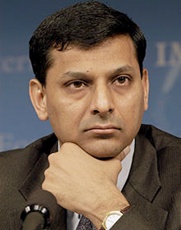Time not yet ripe for rate cut, says RBI governor
02 Dec 2014
The Reserve Bank of India (RBI) has kept its policy rates unchanged during its fifth bi-monthly policy review, dashing business expectations of softer lending rates that would ease borrowing costs and spur economic activity.
 Governor Raghuram Rajan decided to keep key rates unchanged despite mounting pressure to ease borrowing costs to aid a revival, saying that for an effective rate cut, inflation has to steady at a low level.
Governor Raghuram Rajan decided to keep key rates unchanged despite mounting pressure to ease borrowing costs to aid a revival, saying that for an effective rate cut, inflation has to steady at a low level.
Accordingly, RBI kept the policy repo rate under the liquidity adjustment facility (LAF) unchanged at 8.0 per cent and the cash reserve rate (CRR) of scheduled banks at 4.0 per cent of their net demand and time liabilities (NDTL).
RBI said it would continue to provide liquidity under overnight repos at 0.25 per cent of bank-wise NDTL at repo rate and liquidity under 7-day and 14-day term repos of up to 0.75 per cent of NDTL of the banking system through auctions and continue with daily one-day term repos and reverse repos to smooth liquidity.
Consequently, the reverse repo rate under the LAF will also remain unchanged at 7.0 per cent and the marginal standing facility (MSF) rate and the Bank Rate at 9.0 per cent, RBI said.
For the common man, however, unchanged RBI policy rates would imply banks keeping interest rates unchanged on all retail loans, including home loans, vehicle finance and personal loans so that EMIs would remain high.
RBI said overall liquidity conditions have eased considerably in Q3 of 2014-15 due to structural and frictional factors, as well as the fine-tuning of the liquidity adjustment framework.
In fact, with deposit mobilisation outpacing credit growth and currency demand remaining subdued in relation to past trends, banks are flush with funds, leading to a number of banks reducing deposit rates, RBI noted.
Consistent with the balance of risks set out in the fourth bi-monthly monetary policy statement of September, headline inflation has been receding steadily and current readings are below the January 2015 target of 8 per cent as well as the January 2016 target of 6 per cent.
The inflation reading for November, which will become available by mid-December, is expected to show a further softening. Thereafter, however, the favourable base effect that is driving down inflation will dissipate and inflation for December (data release in mid-January) may well rise above current levels.
''A change in the monetary policy stance at the current juncture is premature. However, if the current inflation momentum and changes in inflationary expectations continue, and fiscal developments are encouraging, a change in the monetary policy stance is likely early next year, including outside the policy review cycle,'' Rajan said.
According to RBI, global economic growth has been tepid. There has been a slowing of global economy since September, although the sharp fall in the prices of crude oil had a positive impact on economic outlook.
The US economy recovers on the back of stronger domestic consumption, rising investment and industrial activity while in China and the Euro area, headwinds from recessionary forces continue to weaken industrial production and investment sentiment. In Japan, growth may be picking up again on the back of stronger exports, helped in part by further quantitative and qualitative easing that has led to a depreciation of the yen.
Services sector decelerates
RBI noted a deceleration in India's service sector, the driving force of the economy, although, tourist arrivals and domestic and international cargo movements have shown improvement.
While a rise in investment is critical for a sustained pick-up in overall economic activity, RBI said continued low capacity utilisation in some sectors is a dampener.
In this context, the still slow pace of reviving stalled projects, despite government efforts, warrants policy priority as also concerted efforts to ease stress in the financial system.
RBI expects the fall in crude prices to brighten financial outlook, but a weak tax revenue growth and the slow pace of disinvestment suggest some uncertainty about the likely achievement of fiscal targets, and the quality of eventual fiscal adjustment.
The cessation of asset purchases by the US Fed has not negatively impacted financial markets, which have remained generally buoyant on abundant liquidity stemming from accommodative monetary policies in the advanced economies (AEs).
Capital flows to emerging market economies recovered from market turbulence in the first half of October, although some discrimination on the basis of fundamentals is becoming discernible.







.webp)














